Most writers close the muscle car era in 1974, with the loss of the high-performance big-block engines—never mind the high-performance small-blocks, which could sometimes outrace their bigger counterparts. 1974, though, is a fair pick: with soaring gasoline prices and shortages, people were not thinking about muscle so much as mpg.

The Valiant Brougham drew in many former big-Chrysler, big-Dodge, and big-Plymouth owners, thanks to its high trim—the interior was almost as dressy as that of the Fury. It was not unusual for a Chrysler Newport owner to downsize into the Valiant, and the Brougham’s big-car-like trim helped ease the pain of its smaller size and not-big-car ride.
What of the police, in all this? Plymouth had garnered a huge share of the police market by making ready-made cars with heavy-duty equipment, carefully developed by engineers working with officers across the country. The result was extra-tough cars that could handle and stop well, with premium engines chosen for a mix of performance, low maintenance, and thrift.
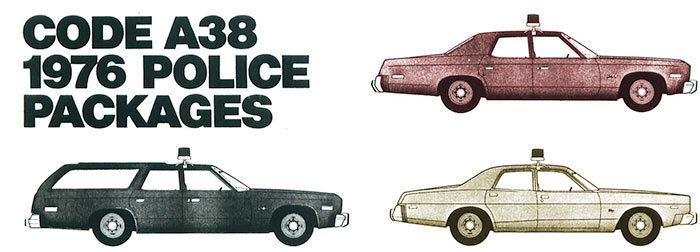
Plymouth fielded three 1976 sedans with the police package: the small A-body Valiant, the midsize B-body Fury, and the large C-body Gran Fury. In the past, police had generally insisted on the larger cars, the Gran Fury size, but the midsize Fury (and its Dodge twin) quickly became the most popular police car in America—and why not? The interior of the Fury was more than big enough, while its speed, handling, and maneuverability were better than the four-inch-longer, 2-inch-wider Gran Fury.
The Valiant should have been the cornering king of the three (and indeed the later M-body Diplomat/Gran Fury were about the same size as the Valiant), with nineteen inches less length but only 7.5 inches less wheelbase; the wheels were closer to the corners of the car, though there was still an immense amount of overhang.
All the Mopar squads came with 65-amp or 100-amp alternators, quite strong at a time when a typical car had a 30-40 amp alternator. On every car but the Valiant, disc brakes were standard (manual discs, too, except with the 360, 400, and 440 engines). The Volare is listed as being available, but doesn't seem to have had a police package—or perhaps it was just not ready yet when our fact sheet was prepared.
Engines ranged from the slant six (except on the Gran Fury) to the E86 440 high-performance edition with twin exhausts and catalytic converters. The police were advised to get the 360 four-barrel, 400 four-barrel, or 440 four-barrel; and with the police package, these included an engine oil cooler. The 360 four-barrel was sold on the Valiant Pursuit, the largest engine the Valiant could have; it would later also be used on Volare Pursuits and then on Diplomat/Gran Fury cars. (Precious few Valiant police cars were sold; indeed, few 1976 Valiants were made.)
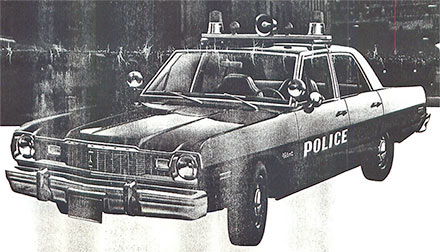
There was a special handling package for the small-block V8s that included special sway bars, torsion bars, rear leaf springs, control arms and pivots, and shock absorbers. Even the 225 slant six had a heavy duty suspension, using heavy duty torsion bars, rear leaf springs, front sway bars, and shock absorbers. Special firm-feel police chucks, to be in high demand at junkyards and dealer parts stores, were used with the V8s when they had power steering, which one would imagine would be nearly always. The police bias-ply tires were good up to 100 mph; above that, the company warned that buyers absolutely need certified high-speed radial tires with fabric belts, standard on all their V8 sedans with police packages, and optional on the wagons and slant sixes. The rear sway bar was left out of the wagons and six-cylinder Valiants.
Heavy-duty vinyl seat covers with heavy-duty springs were also part of the package; personal experience revealed the vinyl to be almost invincible over 150,000 miles, while the extra-firm seat springs made sitting on the front seats like sitting on a park bench, with about the same amount of support around fast turns.
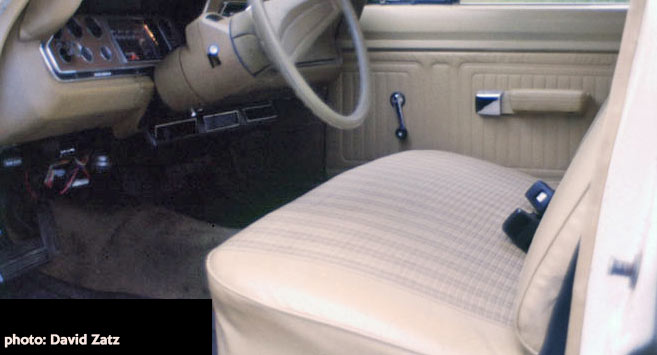
The police packages included numerous additional welds, making for a stiffer, longer-lasting body; the handling of the police cars was greatly improved by this alone, the heavier-duty suspension parts and brakes pitching in to make them more than a match for pretty much any evildoer on the road, even with a less powerful engine than crooks might have. Heavy duty and special handling packages were standard on the police packages—except in the Chrysler Newport wagon.
The 225 slant six was rated at 100 horsepower, with 170 pound-feet of torque; many city police departments found this to be all they needed. The 318 two-barrel was a jump up to 10 horsepower and 255 pound-feet; going to the 360 added just 20 horsepower and 25 pound-feet. The 360 was the base engine for the Gran Fury.
The real performance engines started with the four-barrel 360, at 220 horsepower and 280 pound-feet of torque—not quite up to today’s Pentastar V6; this was the top Valiant engine, only available on the Valiant.
The first big-block V8 was the tame 400, with 175 horsepower and 300 pound-feet of torque—not a huge leap over the 360, but drinking more fuel. Two four-barrel versions were available, the E64 with Lean Burn (210 hp/305 lb-ft) and the E68 without it (240 hp/325 lb-ft); the E68 was the first engine with dual exhaust, other than the 360 four-barrel. The E85 440 four-barrel was only used on Gran Fury wagons; the E86 440, with a four-barrel, dual exhaust, and dual cats topped the range at 255 horsepower and 355 pound-feet of torque.
California numbers were lower, across the board—around 5 to 10 horsepower was bled off with extra emissions equipment, at that time still rather crude (internal engineers, including the head of engine tuning, were already asking for fuel injection to solve these woes and all the drivability issues of the day). Torque was down as well, by about the same amount. Most of the engines were available in California; they also had a single-exhaust 360 four-barrel, with the same power and torque ratings (175/270). No two-barrel 360 or 400 was available in California.
It was an interesting time for police cars; the Volare would soon have its own police package, a fairly rare item (used by, among others, military police and the movie Strange Brew) which was likely a good fit for many departments. Within a few years, the Dodge Diplomat and Plymouth Gran Fury, based off the Volare, would start dominating police cars—which they continued to do until their final year, 1989. Police cars may have been downsizing, but Plymouth was on top of the trends, and Mopar engineers were making every car that fit the bill, fit for law enforcement.
More on the police Valiants at Valiant.Org
 Dodge Intrepid: the police car
Dodge Intrepid: the police car
Agile, surprisingly quick front while drive pursuit vehicles
 Plymouth police cars of 1976
Plymouth police cars of 1976
Downsized but strong
 Car Spotter: 1971 Plymouth Fury Pursuit Car
Car Spotter: 1971 Plymouth Fury Pursuit Car
Big and classy police car
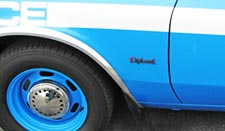 Making police cars: who and what was involved?
Making police cars: who and what was involved?
Diving into the changes that make an ordinary car into a pursuit vehicle (or just an ordinary police car)
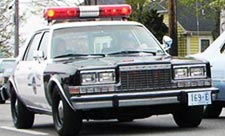 Prototypical police cars: Dodge Diplomat and Plymouth Gran Fury
Prototypical police cars: Dodge Diplomat and Plymouth Gran Fury
Inside the M-body Dodge Diplomat and Plymouth Gran Fury that defined how police cars should look for at least a decade
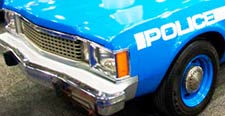 Mopar police cars of 1980: St. Regis/Gran Fury, Aspen/Volare, B-Van
Mopar police cars of 1980: St. Regis/Gran Fury, Aspen/Volare, B-Van
The last of the big Plymouth and Dodge police cars, in their penultimate year, with the final F-body squads
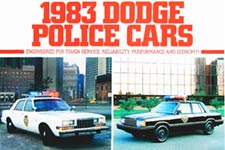 Mopar police cars of 1983: Diplomat/Gran Fury and Reliant/Aries
Mopar police cars of 1983: Diplomat/Gran Fury and Reliant/Aries
Two quite different approaches to police cars, with front and rear wheel drive, powered by V8 and four-cylinder engines
Copyright © 2021-2025 Zatz LLC • Chrysler / Mopar car stories and history.
YouTube • Editorial Guidelines • Videos
Tailfins Archive • MoTales on BlueSky